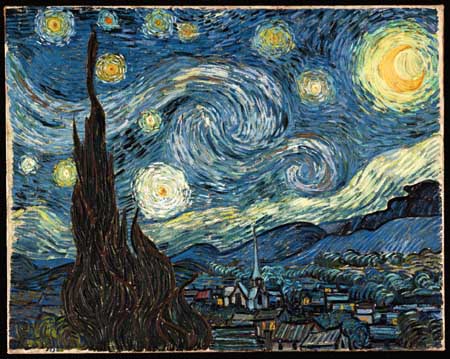The next morning, I said goodbye to the Pinoys. In the Philippines, I would have been peeved by their heedless blather, but here in Nowhereland, Italy, it allayed more than annoyed. I miss my peeps. I wished them bonne route back to Turin, and to escape a tedious explanation of our road trip I told them we were going back to Paris. But home was really one more week away.
The road back to France was a long one, I slept part of the way and when I woke up we were in Provence.
 |
| H and the unibrow house |
 |
| EXHIBIT A. Pont d'Avignon. |
 |
| EXHIBIT B. Inside a Van Gogh painting, Arles. |
The land of lavender and ceramic cicadas got its name because it was the first Roman province beyond the Alps, but it is much older than the Roman Empire. Primitive Gaulish and Celtic tribes planted themselves here, early civilizations were also established by the Persians and Greeks. But these were nothing compared to the western expansion of the Roman juggernaut.
 | |
| Coliseum in Arles Where a Johnny Halliday concert was to be held the same night. |
 | |
| The Arenee in Nimes Where men still fight bulls. |
But, I'm getting ahead of myself here. First, allow me to tell you about Saint-Rémy.
There are many reasons to visit this town on the Alpilles (little Alps). If you are a fan of astrology and the occult, the man who used to live here would be familiar.
This was the birthplace of Michel de Nostredame, the Jewish physician more popularly known as Nostradamus.
When I was in my early teens, a movie about Nostradamus' indisputable predictions was very popular on Betamax and VHS. It was narrated by no less than the great Orson Welles, and it scared the pants out of me. This was during the Iraq War, and there was an End-of-Days pandemic. The prophecies of Nostradamus were allegedly coming true; according to the movie's dramatic portrayal, some guy in a blue turban was supposed to sow terror in the New World. I think he meant the Smurfs.
The Saint-Rémy of Nostradamus in the Renaissance didn't look so different from the Saint-Rémy of today, with the exception of a few details.
Another popular name is etched on this extensive mansion a few streets away from Nostradamus' house.
It is the Hôtel de Sade, an archaeological museum for important finds from the ruins of the ancient city of Glanum. And although the name might be infamous, they were only distant relatives of the notorious agent provocateur, Marquis de Sade.
But for sightseers, one name stands apart from all others. For some, walking in his footsteps is the sole reason for coming here at all. And I suppose for some people that can be so annoying, enough to put up a sign like below --
In French, the sign reads: "Van Gogh wasn't born in this house. He didn't die here either."
Saint-Rémy has an extreme case of the hots for Vincent Van Gogh, and the feelings were mutual. The tortured painter stayed just a year here but made 150 paintings inspired by the town before he moved to Auvers-sur-Oise, where he shot himself two months later.
 |
| The lavender field in the back. See the painting here. |
 |
| Sunflowers. I wonder if they made him as happy as they make me. |
Saint Paul-de-Mausole is a former monastery that was turned into an asylum. Except for the two rooms that Van Gogh occupied and the cloister of the wing where he stayed, the rest of the hospital is still accepting patients up to this day.
 |
| The artist's spartan room |
 |
| Actually, I think this was his bedroom in Arles, when he cohabited with Gaugin. I'm no art major, I only know this from the movie so correct me if I'm wrong. |
 |
| The peaceful cloister. See painting here. |
 |
| H catches me resting my tired old feet. |
 |
| The actual olive trees from the painting. |
The asylum where he stayed and its surroundings were the subjects of many of his paintings. This was his swirly period, when in his pain he produced the most exquisite works of his short artistic life. His most famous subject, his most famous painting of all, was the town of Saint-Rémy. It is the haunting star-lit burg in La Nuit étoilée, The Starry Night.
 |
| From Codart.nl |
On our first night in Saint-Rémy, we dined under the stars. The clear black sky was perfect for stargazing. I lay on our quilt and clutched my glass of wine as if it were an anchor, in case I got swept away by the celestial stream. I brought out my watercolors just in case the muse would visit me here, but of course my sophomoric attempts at painting cypress trees did not produce anything as haunting as Van Gogh's Cypresses. Maybe the great car debacle of 2011 didn't torture me enough; or maybe I should consider shifting to oil painting. Haha, as if.
The following day gave me the torture I was looking for. From Saint Paul de Mausole we walked to the nearby ruins of Glanum and unconsciously spent two hours inspecting every inch of the abandoned city of the western Roman empire. From the top, we saw this - Saint-Rémy, as it looked in The Starry Night.
Up Next: Glanum to Meet Ya
Related Posts:
A Year in France Celebration (The Aftermath)
Sizzling Beach 1, Sizzling Beach 2, Sizzling Beach 3
Bella Italia 1, Bella Italia 2, Bella Italia 3, Bella Italia 4, Bella Italia 5

















No comments:
Post a Comment